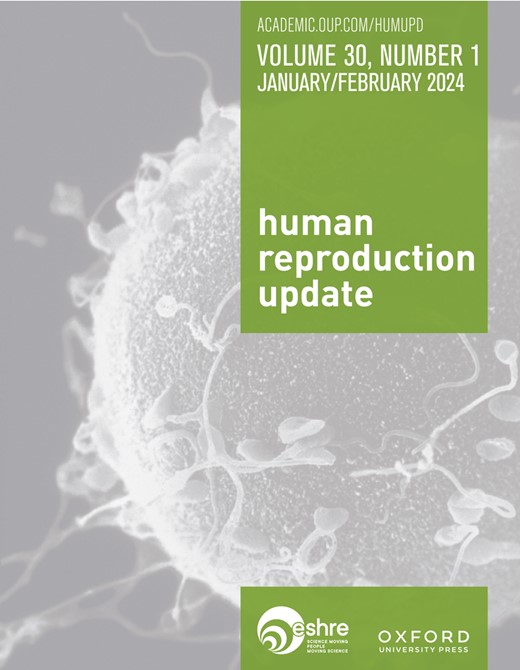Modeling the extension of ovarian function after therapeutic targeting of the primordial follicle reserve
IF 16.1
1区 医学
Q1 OBSTETRICS & GYNECOLOGY
引用次数: 0
Abstract
BACKGROUND Women are increasingly choosing to delay childbirth, and those with low ovarian reserves indicative of primary ovarian insufficiency are at risk for sub- and infertility and also the early onset of menopause. Experimental strategies that promise to extend the duration of ovarian function in women are currently being developed. One strategy is to slow the rate of loss of existing primordial follicles (PFs), and a second is to increase, or ‘boost’, the number of autologous PFs in the human ovary. In both cases, the duration of ovarian function would be expected to be lengthened, and menopause would be delayed. This might be accompanied by an extended production of mature oocytes of sufficient quality to extend the fertile lifespan. OBJECTIVE AND RATIONALE In this work, we consider how slowing physiological ovarian aging might improve the health and well-being of patients, and summarize the current state-of-the-art of approaches being developed. We then use mathematical modeling to determine how interventions are likely to influence the duration of ovarian function quantitatively. Finally, we consider efficacy benchmarks that should be achieved so that individuals will benefit, and propose criteria that could be used to monitor ongoing efficacy in different patients as these strategies are being validated. SEARCH METHODS Current methods to estimate the size of the ovarian reserve and its relationship to the timing of the menopausal transition and menopause were compiled, and publications establishing methods designed to slow loss of the ovarian reserve or to deliver additional ovarian PFs to patients were identified. OUTCOMES We review our current understanding of the consequences of reproductive aging in women, and compare different approaches that may extend ovarian function in women at risk for POI. We also provide modeling of primordial reserve decay in the presence of therapies that slow PF loss or boost PF numbers. An interactive online tool is provided that estimates how different interventions would impact the duration of ovarian function across the natural population. Modeling output shows that treatments that slow PF loss would need to be applied as early as possible and for many years to achieve significant delay of menopause. In contrast, treatments that add additional PFs should occur as late as possible relative to the onset of menopause. Combined approaches slowing ovarian reserve loss while also boosting numbers of (new) PFs would likely offer some additional benefits in delaying menopause. WIDER IMPLICATIONS Extending ovarian function, and perhaps the fertile lifespan, is on the horizon for at least some patients. Modeling ovarian aging with and without such interventions complements and helps guide the clinical approaches that will achieve this goal. REGISTRATION NUMBER Not applicable.模拟原始卵泡储备治疗后卵巢功能的扩展
越来越多的女性选择推迟生育,而那些卵巢储备不足表明原发性卵巢功能不全的女性有亚不育和不孕症的风险,也有提前绝经的风险。目前正在开发有望延长女性卵巢功能持续时间的实验策略。一种策略是减缓现有原始卵泡(PFs)的流失速度,另一种策略是增加或“增加”人类卵巢中自体卵泡的数量。在这两种情况下,卵巢功能的持续时间将被延长,更年期将被推迟。这可能伴随着足够质量的成熟卵母细胞的延长生产,以延长生育寿命。目的和原理在这项工作中,我们考虑如何减缓卵巢生理衰老可能改善患者的健康和福祉,并总结目前正在开发的最新方法。然后,我们使用数学模型来确定干预措施是如何定量影响卵巢功能持续时间的。最后,我们考虑了应该达到的疗效基准,以便个体受益,并提出了可用于监测不同患者持续疗效的标准,因为这些策略正在验证中。检索方法汇编了目前估计卵巢储备大小及其与绝经过渡和绝经时间的关系的方法,并确定了建立旨在减缓卵巢储备损失或向患者提供额外卵巢PFs的方法的出版物。我们回顾了目前对女性生殖衰老后果的理解,并比较了可能延长POI风险女性卵巢功能的不同方法。我们还提供了在减缓PF损失或增加PF数量的疗法存在下的原始储备衰减模型。提供了一个交互式在线工具,估计不同的干预措施将如何影响自然人群卵巢功能的持续时间。模型输出显示,减缓PF损失的治疗需要尽早应用,并持续多年,以实现更年期的显著延迟。相反,增加额外的PFs的治疗应该尽可能晚于绝经的开始。结合减缓卵巢储备损失的方法,同时增加(新的)PFs的数量,可能会在延迟更年期方面提供一些额外的好处。至少对一些患者来说,延长卵巢功能,甚至可能延长可生育的寿命即将到来。模拟卵巢衰老有或没有这样的干预补充和帮助指导临床方法,将实现这一目标。注册号不适用。
本文章由计算机程序翻译,如有差异,请以英文原文为准。
求助全文
约1分钟内获得全文
求助全文
来源期刊

Human Reproduction Update
医学-妇产科学
CiteScore
28.80
自引率
1.50%
发文量
38
期刊介绍:
Human Reproduction Update is the leading journal in its field, boasting a Journal Impact FactorTM of 13.3 and ranked first in Obstetrics & Gynecology and Reproductive Biology (Source: Journal Citation ReportsTM from Clarivate, 2023). It specializes in publishing comprehensive and systematic review articles covering various aspects of human reproductive physiology and medicine.
The journal prioritizes basic, transitional, and clinical topics related to reproduction, encompassing areas such as andrology, embryology, infertility, gynaecology, pregnancy, reproductive endocrinology, reproductive epidemiology, reproductive genetics, reproductive immunology, and reproductive oncology. Human Reproduction Update is published on behalf of the European Society of Human Reproduction and Embryology (ESHRE), maintaining the highest scientific and editorial standards.
 求助内容:
求助内容: 应助结果提醒方式:
应助结果提醒方式:


